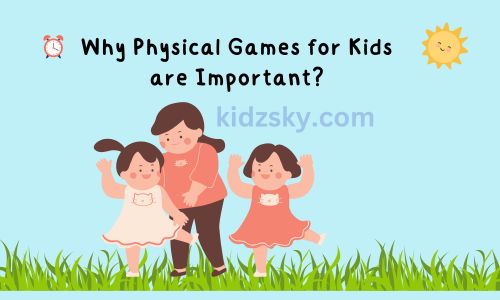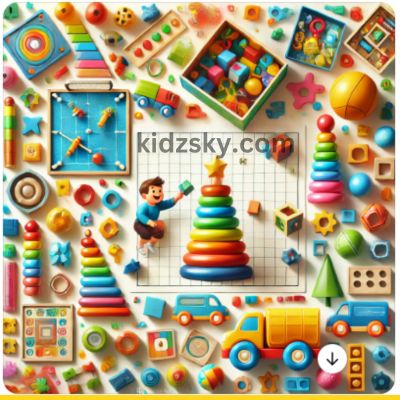We all know it’s impossible to encourage children to engage in physical games and activities, so check our list of the best physical games for kids, which is more important than ever
While mobile and video games can be fun and engaging, physical games offer children a wide range of benefits that positively affect their health, development, and well-being
In this blog, we will discuss the best physical games for kids, how each game is played, its benefits, and why kids need to participate in regular physical activity.

Why Physical Games for Kids are Important?
Physical games provide much more than just entertainmentThey are essential for kids’ physical, mental, and emotional development
Physical games or activities help children develop good health and muscles and bones, which also help improve cardiovascular health and maintain a healthy weight.
Daily Physical activity enhances kids’ coordination, motor skills, balance, and flexibilityBeyond the physical benefits, these activities foster social skills, teamwork, and discipline.
Compared to mobile games, which often encourage sedentary behavior and limited social interaction, physical games promote active lifestyles and peer collaboration
By integrating fun with movement, the best physical games for kids allow them to learn, grow, and develop naturally and enjoyably.
Popular Post:- How to Develop Good Eating Habits in Kids

Benefits of Physical Activity
Before revealing the list of the best physical games for kids, let’s check the key benefits of regular physical activity for children:
- Promotes Physical Health: Physical activity helps build strong bones, muscles, and jointsIt improves heart health and decreases the risk of obesity and conditions like type 2 diabetes.
- Enhances Mental Health: Daily physical activity or exercise releases endorphins from our body, which can help reduce stress and anxietyPhysical games also improve focus and cognitive function, benefiting academic performance.
- Improves Social Skills: Many physical games involve teamwork, cooperation, and communicationThese experiences teach children how to interact with peers and improve social skills.
- Boosts Confidence and Self-Esteem: Participating in games and physical activities allows children to master new skills, increasing their confidence and self-esteem.
- Increases Focus and Concentration: Physical activity helps improve attention span and focus, allowing kids to perform better in school and other activities, which enables them to become future-ready.
- Encourages Healthy Habits for Life: Engaging in physical activities from a young age enables children to develop lifelong habits of staying active, contributing to a healthier lifestyle as they grow.
Here are some of the best physical games for kids that are fun and beneficial for their overall development.

Best Physical Games for Kids
- 1Tag
Tag is a classic game that involves one child being “it” and chasing other players until they tag someone, who then becomes “it.” This game can be played in various forms, such as freeze tag or tunnel tag.
Benefits: Tag is excellent for developing cardiovascular endurance, agility, and speedIt also improves social skills as children learn to strategize and work together.
- 2Hide and Seek
How to Play: One child counts while the others hideAfter counting to a set number, the seeker tries to find the hidden playersThe first person found becomes the next seeker.
Benefits: Hide and seek help to improve problem-solving skills and spatial awarenessPhysically, it involves running, squatting, and crouching, enhancing flexibility and stamina.
- 3Duck, Duck, Goose
How to Play: Children sit in a circle, and one player walks around tapping others on the head, saying “duck.” When they say “goose,” the tapped child must chase them around the circle and try to tag them before they take the vacant spot.
Benefits: This game encourages quick thinking, improves hand-eye coordination, and increases speed and agilityIt’s one of the best physical games for kids, teaching them to anticipate and react quickly.
- 4Hopscotch
How to Play: Draw a hopscotch grid on the ground using chalkPlayers take turns tossing a small object, such as a stone, onto the numbered squares and hop through the grid on one or two feet, skipping the square where the object landed.
Benefits: Hopscotch enhances balance, coordination, and leg strengthIt also helps kids practice counting and spatial awareness.
- 5Simon Says
How to Play: One person is Simon and gives commands, like “Simon says touch your toes.” The trick is that players must only follow commands preceded by “Simon says.” If they follow a command without, “Simon says,” they’re out.
Benefits: This game improves listening skills, focus, and reaction timePhysically, it gets kids moving in various ways, from jumping to touching their toesWe chose this activity on our Physical Games for Kids list.
- 6Red Light, Green Light
How to Play: One player stands at one end of a playing area and the rest at the opposite endWhen the leader says “green light,” the children run toward them, but when they say “red light,” everyone must stopAnyone moving on the “red light” must return to the start.
Benefits: This game teaches self-control, patience, and quick decision-makingThis also helps children improve their sprinting and stopping skills.
- 7Obstacle Course
How to Play: Set up a series of obstacles for children to navigate, such as crawling under tables, jumping over cones, or balancing on a beamThe course can be timed for extra excitement.
Benefits: Obstacle courses challenge children’s agility, balance, coordination, and strengthIt’s a fun way to develop motor skills and enhance problem-solving abilities.
- 8Jump Rope
How to Play: Children can jump solo or in a group with a long rope, jumping over the rope as it swings around.
Benefits: Jumping rope is an excellent cardiovascular workout that improves coordination, timing, and enduranceIt’s one of the best physical games for kids to enhance overall fitness.
- 9Relay Races
How to Play: Children are divided into teams and race from one point to another, passing a baton or completing challenges like sack races.
Benefits: Relay races promote teamwork, speed, and coordinationThey also teach children the importance of working together to achieve a common goal.
- 10Ball Games (Soccer, Basketball, Dodgeball)
How to Play: Ball games vary depending on the sportChildren try to score goals in soccer by kicking the ball into a netIn basketball, they aim to shoot the ball into a hoopDodgeball involves avoiding being hit by thrown balls while trying to hit others.
Benefits: Ball games improve hand-eye coordination, agility, and teamworkThey also enhance cardiovascular health and develop strategic thinkingAll ball game activities are essential, so we discussed these all-in-one activities in our Physical Games for Kids list.

The Impact of Physical Games on Kids’ Health
Physical games are fun and vital to children’s overall health and developmentPlaying active games helps to build strong muscles, maintain a healthy weight, and improve cardiovascular health. It also enhances flexibility, endurance, and motor skills.
One of the most significant benefits of the best physical games for kids is the impact on mental healthRegular physical activity has been proven to reduce stress, anxiety, and depression in children
It boosts mood, improves sleep, and enhances concentrationThese positive effects extend into the classroom, where physically active children often perform better academically and exhibit better behavior.
Moreover, physical games foster essential life skills such as teamwork, communication, problem-solving, and leadershipThese experiences help children become well-rounded individuals with confidence, empathy, and resilience.
Why Physical Games Are Better Than Mobile Games
While mobile games can be entertaining, they don’t offer the same physical and social benefits that come with active playToo much screen time can lead to sedentary or bad behavior, poor posture, eye strain, and obesity
On the other hand, physical games get kids moving, interacting with peers, and learning how to navigate real-world challenges.
The best physical games teach kids the importance of exercise, teamwork, and healthy competitionActivity stimulates the body and mind, helping kids become active, confident individuals.
Conclusion
Suppose you Plan to incorporate these Physical Games for Kids into your kid’s daily routineIn that case, it will help them be active and healthyIt contributes to their mental, emotional, and social development
Games like tag, hide and seek, hopscotch, and ball games offer children endless opportunities to learn, grow, and stay fitAs parents and educators, promoting physical activity is vital to helping kids build a foundation of healthy habits that will last a lifetime.
Encourage your children to get up, move, and play these exciting physical games!
Admin creates all Photos used in this blog in Canva.




[…] Our Popular Post:- Top 10 Best Physical Games for Kids […]
[…] Also Read:- Top 10 Best Physical Games for Kids […]
[…] Also Read:- Top 10 Best Physical Games for Kids […]
[…] Also Read:- Top 10 Best Physical Games for Kids […]
[…] Also Read:- Top 10 Best Physical Games for Kids […]